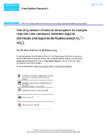Use of quantum-chemical descriptors to analyse reaction rate constants between organic chemicals and superoxide/hydroperoxyl (O2•−/HO2•)

Open access
Date
2018Type
- Journal Article
Abstract
The reaction between superoxide (O2•−) and organic chemicals is of interest in many scientific disciplines including biology and synthetic chemistry, as well as for the evaluation of chemical fate in the environment. Due to limited data and lack of congeneric modelling, the involvement of superoxide in many complex processes cannot be adequately evaluated. In this study, we developed new quantitative structure–property relationship (QSPR) models for the prediction of the aqueous-phase rate constant for the reaction between superoxide and a wide variety of organic chemicals reacting via one-electron oxidation, reduction and hydrogen-transfer. It is shown that the relative importance of these pathways is related to frontier molecular orbital (FMO) interaction and to pH. The class-specific QSPRs developed have good statistics (0.84 ≤ R2 ≤ 0.92). For non-congeneric chemicals it is demonstrated that the reactivity toward superoxide can be described by applying explicit descriptions for competition kinetics and speciation. Therefore, the relationships developed in this study are useful as a starting point to evaluate more complex molecules having, for example, multiple reactive functional groups, labile H bonds, or delocalised cationic charges. However, additional kinetic data and more rigorous computation are needed to evaluate such molecules. Show more
Permanent link
https://doi.org/10.3929/ethz-b-000313483Publication status
publishedExternal links
Journal / series
Free Radical ResearchVolume
Pages / Article No.
Publisher
Taylor & FrancisSubject
Superoxide; hydroperoxyl; radicals; antioxidants; reaction rate constants; quantitative structure-property relationship; organic chemicals; frontier molecular orbital; kineticsMore
Show all metadata




